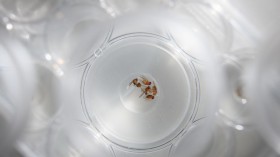Researchers have determined that brain wave synchronization is critical for the brain to absorb and categorize, according to a recent study.
The study, which was published in the journal Neuron, details how researchers determined that neural activity in two parts of the brain that occur during learning actually synchronize their signal oscillations after a staggered start.
According to the study, past work has determined that when a brain is presented with new information, neurons in the striatum - a region associated with habit forming - become active first. Following this activation, neurons in the prefrontal cortex - the main control system of the brain - then begin to come to life.
To determine if these two activations influence one another or are isolated occurrences, the researchers used electroencephalography (EEG) scans to measure the brain waves of monkeys as they learned to sort dot patterns into two categories.
The monkeys were gradually introduced to more and more dot patterns over the course of the experiment, learning 256 dot patterns in all.
Researchers paid special attention to the monkey's brain activity when they began to figure out how to recognize the traits that characterized the two categories that the dot patterns could be sorted into.
They quickly recognized that around this moment, in every monkey new brain wave patterns called "beta bands" appeared in their EEGs. Interestingly, these new bands, which were being produced by both the striatum and prefrontal cortex, began to synchronize.
"There is some unknown mechanism that allows these resonance patterns to form, and these circuits start humming together," senior author Earl Miller said in a recent statement.
According to Miller, with the synching of these waves, a new pair of electrical signal connections bridged the striatum and prefrontal cortex. The researchers theorize that this pair of circuits correspond to each of the two categories.
"Category-learning results in new functional circuits between these two areas," Miller added. "We're seeing direct evidence for the interactions between these two systems during learning, which hasn't been seen before."
The authors of the study say that a lot more research will be needed to determine exactly how and why this phenomenon occurs.
The study was published in Neuron, a Cell publication, on June 12.
© 2024 NatureWorldNews.com All rights reserved. Do not reproduce without permission.





